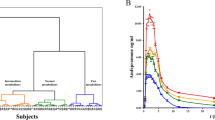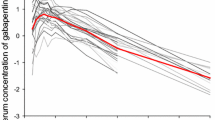Summary
Bufuralol (Ro 34787, Angium®) is a non selective β-adrenoceptor blocking drug with some degree of sympathomimetic action and a longer duration of action than propranolol. Plasma concentrations of bufuralol and 1 -hydroxybufuralol, its main blood derivative which shows similar β-adrenoceptor blocking properties, were determined in healthy volunteers after a 60 mg oral and a 20 mg intravenous dose. Peak plasma concentrations were higher for the parent drug but due to a longer elimination half-life, the metabolite concentrations became higher after a few hours (bufuralol t1/2=2.7±0.9 h, metabolite t1/2=6.1±l.5h) The bioavailability of the tablet tested was 46±15%.
The occurrence of side-effects in a subject with abnormal pharmacokinetics of the drug in this study and in a previous study with this drug suggested the possibility of a pharmacogenetic anomaly. Determination of the plasma metabolic ratio in the family of this subject and in a larger population confirmed that aliphatic hydroxylation of bufuralol is under polymorphic control. Phenotyping of our volunteers whith debrisoquine showed the present pharmacogenetic anomaly to be the same as the one reported for debrisoquine alicyclic hydroxylation. The occurrence of side-effects in poor metabolizers as seen with bufuralol illustrates the clinical relevance of the hydroxylation polymorphism. In Switzerland the frequency of poor metabolizers is about 9% as previously reported for Caucasian British subjects.
Similar content being viewed by others
References
Kilborn J.R., Turner P. (1974): Ro 3–4787, a new β-adrenoceptor blocking agent: studies in normal volunteers. Br. J. clin. Pharmac.1, 143–149.
Tschopp J.M., Gorgia A., Balant L., Revilland C., Francis R.J., Fabre J. (1978): Rôle des métabolites dans les relations entre la pharmacocinétique et l’effet des agents β-bloquants. Expériences avec le tolamolol et le bufuralol. Schweiz, med. Wschr.108, 756–764.
Francis R.J., Allen J.G., East P.B., Ruane R.J. (1976): The metabolism of bufuralol: urinary metabolite profiles in rat, dog and man. Europ. J. Drug. Metab. Pharmacokin.1, 113–124.
Francis R.J., East P.B., McLaren S.J., Larman J. (1976): Determination of bufuralol and its metabolites in plasma by mass fragmentography and by gas chromatography with electron capture detection. Biomed. Mass. Spectrom.3, 281–285.
Balant L., Francis R.J., Tschopp J-M., Tinguely D., Estreicher J., Fabre J. (1978): Pharmacocinétique du bufuralol chez l’homme. Pharm. Acta Helv.53, 307–313.
Balant L., Francis R.J., Tozer T.N., Marmy A., Tschopp J-M., Fabre J. (1980): Influence of renal failure on the hepatic clearance of bufuralol in man. J. Pharmacokinet. Biopharm.8, 421–438.
Dayer P., Kubli A., Küpfer A., Courvoisier F., Balant L., Fabre J. Defective hydroxylation of bufuralol associated with side-effects of the drug in poor metabolisers. Ssubmitted for publication.
Balant L., Gorgia A., Tschopp J-M., Revillard C., Fabre J. (1976): Pharmacocinétique de deux médicaments β-bloquants: détection d’une anomalie pharmacogénétique? Schweiz. med. Wschr.106, 1403–1407.
Balant L., Dayer P., Fabre J. (1978): Polymorphism in drug metabolism, Br. Med. J.2, 1299.
Mahgoub A., Idle J.R., Dring L.G., Lancaster R., Smith R.L. (1977): Polymorphic hydroxylation of debrisoquine in man. Lancet ii, 584–586.
Price Evans D.A., Mahgoub A., Sloan T.R., Idle J.R., Smith R.L. (1980): A family and population study of the genetic polymorphism of debrisoquine oxydation in a white British population. J. Med. Genet.17, 102–105.
Eichelbaum M., Spannbrucker N., Steincke B., Dengler H.J. (1979): Defective N-Oxidation of sparteine in man: a new pharmacogenetic defect. Eur. J. Clin. Pharmacol.16, 183–187.
Bertilsson L., Dengler H.J., Eichelbaum M., Schulz H.-U. (1980): Pharmacogenetic covariation of defective N-Oxydation of sparteine and 4-hydroxylation of debrisoquine. Eur. J. Clin. Pharmacol.17, 153–155.
Sloan T.P., Mahgoub A., Lancaster R., Idle J.R., Smith R.L. (1978): Polymorphism of carbon oxydation of drugs and clinical implications. Br. Med. J.2, 655–657.
Cotham R.H., Shand D. (1975): Spuriously low plasma propranolol concentrations resulting from blood collection methods. Clin. Pharmacol. Ther.18, 535–538.
Gibaldi M., Perrier D. (1975): Pharmacokinetics. Marcel Dekker, New York and Basle.
Haefelfinger P. (1980): Determination of bufuralol and its major metabolites in plasma by high-performance liquid chromatography. J. Chromatogr.221, 327–335.
Author information
Authors and Affiliations
Rights and permissions
About this article
Cite this article
Dayer, P., Balant, L., Courvoisier, F. et al. The genetic controlof bufuralol metabolisminman. European Journal of Drug Metabolism and Pharmacokinetics 7, 73–77 (1982). https://doi.org/10.1007/BF03189547
Received:
Issue Date:
DOI: https://doi.org/10.1007/BF03189547




